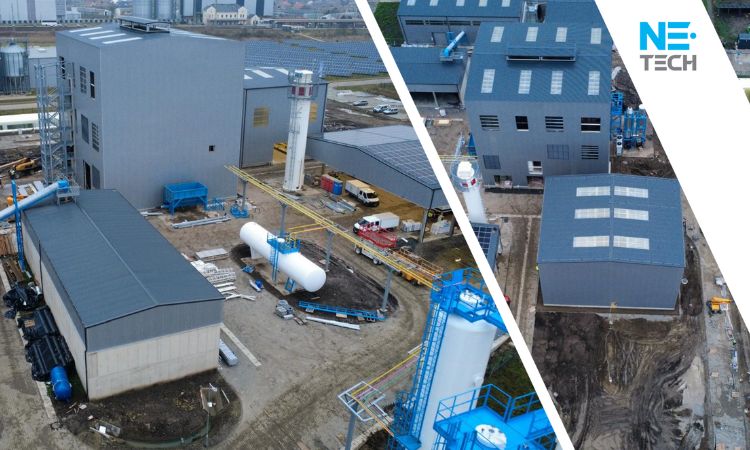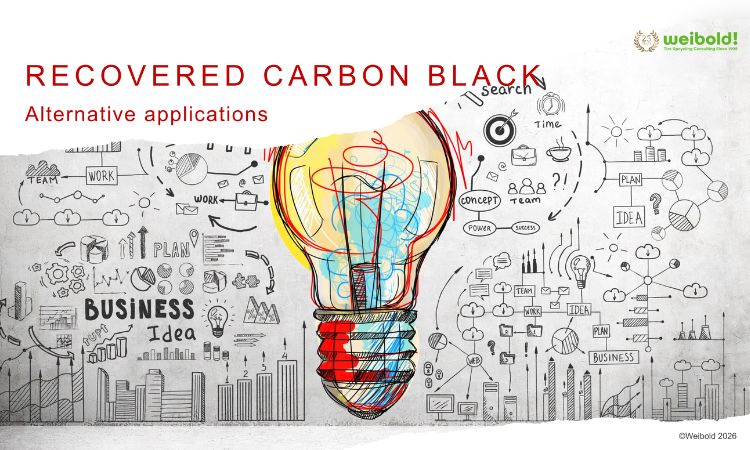Weibold Academy: Innovation in batch-type waste tire pyrolysis technology (part II)
Weibold Academy article series discusses periodically the practical developments and scientific research findings in the end-of-life tire (ELT) recycling and pyrolysis industry. One of the goals is to give entrepreneurs in this industry, project initiators, investors and the public, a better insight into a rapidly growing circular economy. At the same time, this article series should also be a stimulus for discussion.
In our last article (Part I) we addressed the question of how the advantages of a classic batch-reactor process design can be combined with those of a continuous process mode. In the current article (Part II) we address some characteristics and advantages of a batch reactor regarding the thermochemical reactions and their effects on the end products. We refer to the extensive scientific literature and to the findings of successful companies in the industry.
Introduction
In terms of a sustainable, environmentally sound treatment of waste tires, thermochemical conversion technologies (pyrolysis) have become increasingly important in recent years, and some of them have already proven their technical and economic maturity.
Pyrolysis is a thermochemical pathway to treat vulcanized rubber for the recovery of valuable products. It involves the decomposition of the rubber at high temperatures (400 – 900°C) in the absence of an oxygen atmosphere. The main products of pyrolysis are a solid fraction, usually raw recovered carbon black (according to ASTM D8178); a liquid fraction comprised of light oil, heavy oil, and tar; and a permanent gas fraction. [Ramirez-Canon et. al., 2018]
The thermochemical decomposition process (pyrolysis) takes place in a reactor (reaction zone). A distinction is made between batch and continuous filling and processing modes, which in turn significantly determine the reactor design.
Batch-type processes are typically characterized by a completed loading process, followed by completed processing and a subsequent unloading process. Plotting this sequence on a time axis, at different times there are different states (as material concentration in the reactor is changing with the time). In contrast to this, with continuous process designs, the material and the processing are "in flux".
In our last article we concluded that batch-based semi-continuous tire pyrolysis systems can then exploit the advantages of "both worlds" (and even more), if
- the material loading and unloading is automated,
- the end point of complete decomposition can be permanently detected by measuring the pyrolysis gas flow (and the process duration can be continuously adjusted),
- the batch reactors are not exposed to downtimes and are constantly kept at the reaction temperature,
- and the timing of the individual processes has such short intervals that an overall view results in a continuous flow of products.
In summary, it can be stated that modern batch reactors (depending on their design) have great advantages, especially regarding a precise process control with a given inhomogeneity of the feedstock. This is a significant aspect because end-of-life tire deliveries may significantly vary depending on the manufacturer and their proprietary chemical composition. Else, the composition and yields of the products raw recovered carbon Black (raw rCB), oil and gas vary depending on the pyrolysis conditions.
Influence of the reactor model on the product yields
It is evident that the type of reactor has a key influence on oil and permanent gas yields, and on the composition and quality of recovered carbon black. The product yields depend mainly on the thermal decomposition temperature (T), the heating rate (HR) and the residence time (RT) of oil vapors and solid products in the reactor. [LEWANDOWSKI et. al., 2019]
Although the yield of raw rCB is the same in both batch type ("fixed bed") and continuously charged ("moving bed") reactors, provided that the feedstock was completely devolatilized in both, it can be observed that the oil and permanent gas yields are different. The oil yield is higher in a batch reactor whereas the (incondensable) permanent gas yield is higher in a moving bed reactor (e.g., Rotary kiln or Auger). The higher gas yield can be attributed to a faster heating rate and longer gas residence time (oil vapor) in a continuously charged moving bed reactor where a more severe cracking occurs. [AYLON et. al., 2008]
The higher oil yield in a batch reactor has a practical economic benefit since higher product sales can be achieved. At the same time, the (lower) yield of permanent gas with modern batch reactor designs is still sufficient to generate the necessary process heat and the waste heat from the flue gas can be used for further process steps.
Influence of the decomposition temperature and vapor residence time
Beside natural rubber (NR) the most common (synthetic) rubbers used in the manufacture of tires are cis-polybutadiene rubber (CBR), isobutylene-isoprene copolymer rubber (e.g., butyl rubber (BR)) and styrene-butadiene copolymer rubber (SBR) [KAN et. al., 2017]. The degradation (pyrolysis) takes place mainly over these rubber compounds. These processes are very interlaced and overlap with each other. The pyrolysis process of all rubbers in the tire takes place in parallel at the same time. [GONZALES et.al., 2001]
Various studies suggest that SBR decomposed mainly at higher temperatures, natural rubber (NR) at lower temperatures whilst BR can be decomposed at both higher and lower temperatures [RAMIREZ-CANON et. al., 2018].
Whereas the heating rate (HR) is influenced by the power supplied, the particle size, and thermal conductivity of the feedstock, the temperature (T) affects the types of primary thermal decomposition reactions of organic materials. Prolonging the residence time in the reactor increases the probability of secondary reactions, such as the conversion of oil and char into gas, because the molecules present in the liquid and the remaining solid body decompose to form smaller molecules that enrich the permanent gas fraction. [LEWANDOWSKI et. al., 2019]
Laboratory tests have shown that the yield of liquid increases first to a maximum value at 475 °C, and then decreases to a minimum value at 575 °C. The gas yield increases over the whole temperature range. It is apparent that a sharp optimum exists in temperature at which maximum yield of liquid was achieved probably due to strong cracking of the feedstock at this temperature. However, 475 °C seems to be the optimum temperature to obtain liquid products (oil) from thermochemical conversion of the tire feedstock by pyrolysis technology, since decomposition is complete, and the liquid yields become maximized at this temperature. [ROFIQUL ISLAM et. al., 2010]
High temperatures generally favor the production of oil (liquid fraction) where the highest amount was obtained at 550 °C. However, a further increase of the temperature leads to higher production of gas and a reduction of the liquid fraction compared to that one obtained at 550 °C. [RAMIREZ-CANON et. al., 2018]
In contrast low temperatures around 450 °C result in a high production of raw recovered carbon black (solid fraction). But the solid fraction slightly decreases with a further increase in temperature until 550 °C. At higher temperatures, the solids yield increases again [RAMIREZ-CANON et. al., 2018]. Anyway, various studies have shown that the optimal decomposition temperature for the production of raw recovered carbon black (solid fraction) is between 450 °C and 550 °C.
Also, low temperatures (plus low pressure and short vapor residence time) favor the production of limonene, benzene, toluene, and xylene (BTX) and increase their yield in the oil (TDO). Limonene and BTX are high-value primary chemicals with many noteworthy applications.
High temperatures (above 550 °C) and/or long residence times, however, lead to secondary subsequent cracking reaction of volatiles which (inter alia) promote the undesirable development of aromatic and polycyclic aromatic compounds. [cited in NKOSI et. al., 2021]
Conclusion
In contrast to the continuously charged rotary kiln and auger reactors, which are usually associated with a high heating rate and longer vapor residence time, which in turn can cause undesired secondary reactions, the slower heating rates of modern batch reactors tend to prevent secondary reactions and thus increase - through the limited gas accumulation around the char external area - the value of the recovered carbon black produced. [LOPEZ et. al., 2010; NKOSI et. al., 2021]
The complex and partially overlapping processes that take place during end-of-life tire pyrolysis and the given inhomogeneity of the feedstock (with a chemical composition that cannot be precisely determined for every delivery) underline the importance of precise process control. This, especially regarding the question of a completed devolatilization of all volatile components from the solid fraction and thus the rCB is "dry" but not "roasted" (and / or a subsequent energy-intensive "second" pass would be required).
It is therefore obviously not so much the continuous material feed, but the continuous process progress control that is important for high product quality and the necessary flexibility regarding constantly changing feedstock qualities (even if their variance may appear marginal)!
Considering the easier implementation (and other arguments mentioned), this appears to be a strong argument for a modern, batch-based, and semi-continuous process design.
Literature
- E. Aylon, A. Fernandez-Colino, M. V. Navarro, R. Murillo, T. Garcia, and A. M. Mastral, Waste Tire Pyrolysis: Comparison between Fixed Bed Reactor and Moving Bed Reactor, Ind. Eng. Chem. Res. 2008, 47, 4029–4033
- Felipe Campuzano, Abdul Gani Abdul Jameel, Wen Zhang, Abdul-Hamid Emwas, Andres F. Agudelo, Juan Daniel Martínez, S. Mani Sarathy, On the distillation of waste tire pyrolysis oil: A structural characterization of the derived fractions, Fuel 290 (2021) 120041
- Gonzales, J.F., Encinar, J.M., Canito, J.L., Rodriguez, J.J., 2001. Pyrolysis of auto- mobile tire waste. Influence of operating variables and kinetics study. J. Anal. Appl. Pyrolysis, 58–59.
- T. Kan, V. Strezov, T. Evans, Fuel production from pyrolysis of natural and synthetic rubbers. Fuel 2017, 191, 403–410
- Witold M. Lewandowski, Katarzyna Januszewicza, Wojciech Kosakowski, Efficiency and proportions of waste tyre pyrolysis products depending on the reactor type—A review, Journal of Analytical and Applied Pyrolysis 140 (2019) 25–53
- Gartzen Lopez, Roberto Aguado, Martín Olazar , Miriam Arabiourrutia, Javier Bilbao, Kinetics of scrap tyre pyrolysis under vacuum conditions, Waste Management 29 (2009) 2649–2655
- N. Nkosi, E. Muzenda, J. Gorimbo, M. Belaida, Review Developments in waste tyre thermochemical conversion processes: gasification, pyrolysis and liquefaction, Royal Society of Chemistry, RSC Adv., 2021, 11, 11844
- Augustine Quek, Rajasekhar Balasubramanian, Review Mathematical modeling of rubber tire pyrolysis, Journal of Analytical and Applied Pyrolysis 95 (2012) 1–13
- Anyela Ramirez-Canon, Yahir F. Muñoz-Camelo and Paul Singh, Decomposition of Used Tyre Rubber by Pyrolysis: Enhancement of the Physical Properties of the Liquid Fraction Using a Hydrogen Stream, Environments 2018, 5, 72
- M. Rofiqul Islam, M. Parveen, H. Haniu and M. R. Islam Sarker, Innovation in Pyrolysis Technology for Management of Scrap Tires: a solution of Energy and Environment, International Journal of Environmental Science and Development, Vol. 1, No. 1, pp 89-96, April 2010
- Williams PT. Pyrolysis of waste tyres: A review. Waste Manage 2013; 33(8): 1714–28
Weibold keeps the sole right for publishing. Vienna, 23th May 2021
Weibold is an international consulting company specializing exclusively in end-of-life tire recycling and pyrolysis. Since 1999, we have helped companies grow and build profitable businesses.









